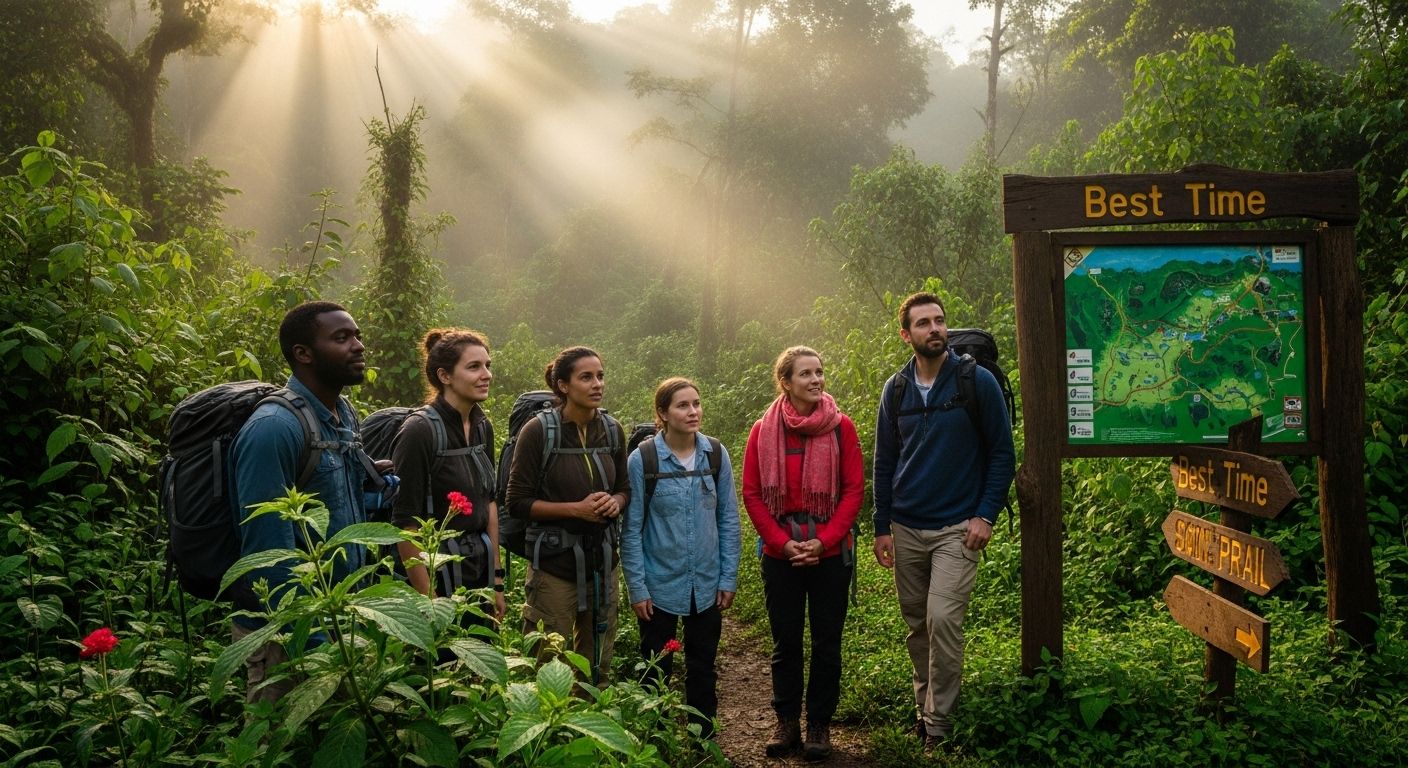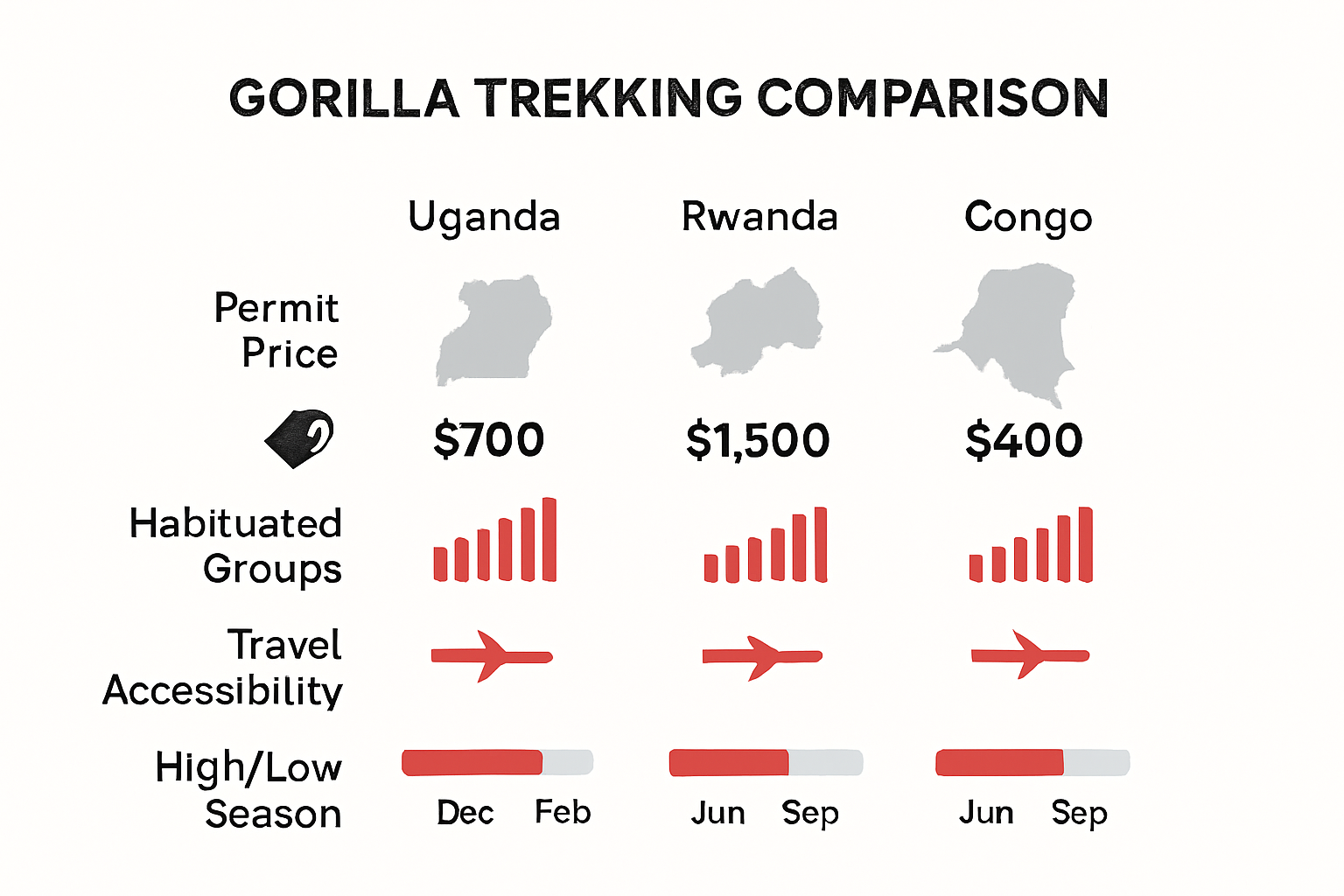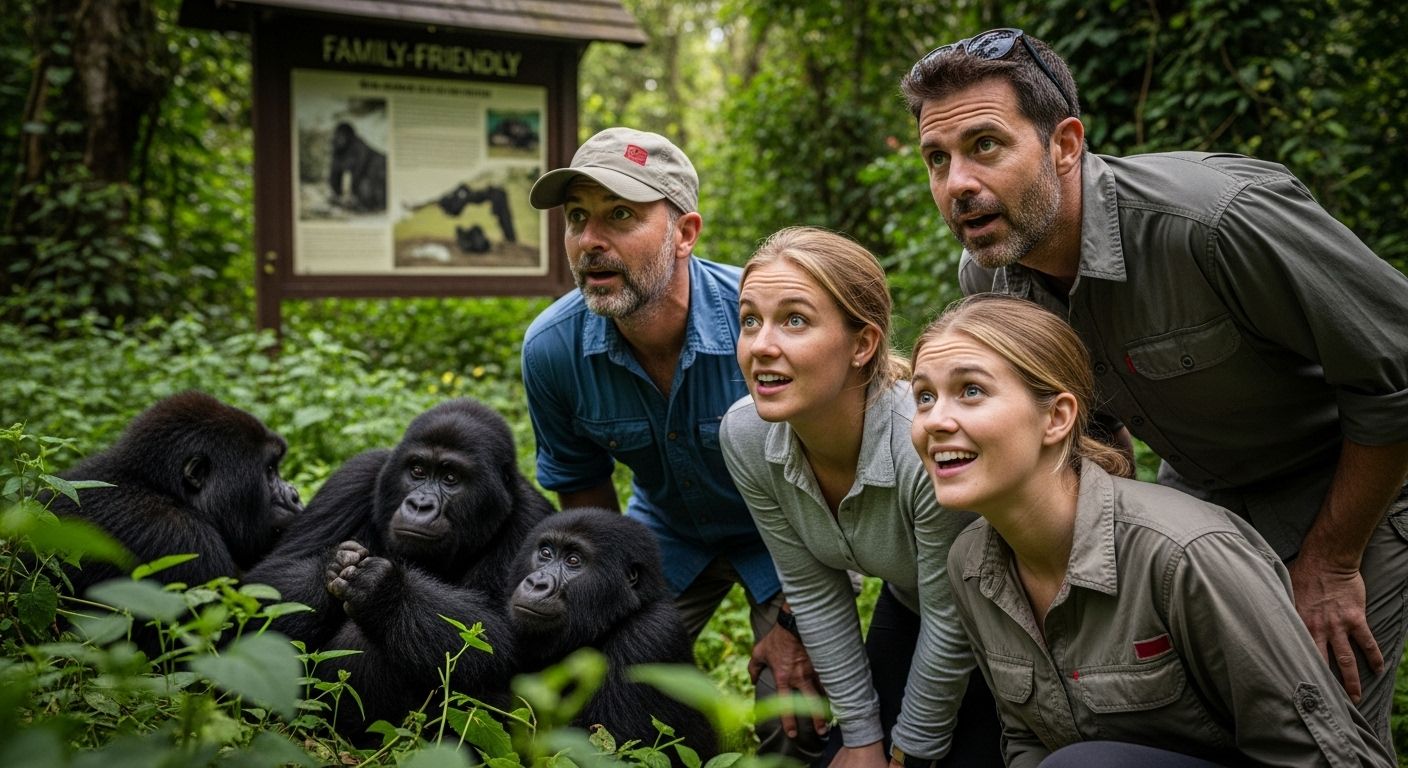Best Time for Gorilla Trekking: Plan Your Perfect Safari
Full Disclosure: Our AI Assistant Writes These!
While we're out in the bush tracking leopards, dodging elephants, and trying to get the perfect sunset shot, our trusty AI companion is back at camp, diligently crafting these blog posts. Don't worry though - it's been trained on years of real safari experiences and only occasionally suggests that tourists should pet the lions. (Please don't pet the lions. The AI was joking. We hope.)
The real reason? SEO loves fresh content, and we love fresh adventures. So while our AI handles the keywords and search rankings, we're out there finding the next hidden waterhole, secret viewpoint, or that one tree where the leopards always hang out. Win-win, really!
Best Time for Gorilla Trekking: Plan Your Perfect Safari

Gorilla trekking has climbed to the top of African safari bucket lists with travellers from around the world craving a glimpse of these incredible primates in their natural home. Most people think getting the timing right just means avoiding the rainy season. But here’s a stunner. Uganda holds nearly half the world’s mountain gorillas and permits here can be up to 50 percent cheaper than in neighboring Rwanda. The real secret to the perfect trek has more to do with choosing the right season and destination combo than everything you’ve ever heard in safari brochures.
Table of Contents
- Seasonal Weather and Gorilla Viewing Experiences
- Peak vs Off-Peak Months for Gorilla Tracking
- Choosing the Right Destination: Uganda, Rwanda, or Congo?
- Tips for Families, Solo Travellers, and Budget Safaris
Quick Summary
| Takeaway | Explanation |
|---|---|
| Choose dry season for best views | Dry seasons from June to February provide clearer trails and more visible gorillas due to reduced foliage. |
| Consider off-peak months for savings | Off-peak months, March-May and October-November, offer lower prices and fewer crowds, enhancing personal interactions with wildlife. |
| Know your destination’s strengths | Uganda offers affordability and diversity, Rwanda provides luxury and ease, while Congo appeals to adventurous spirits. |
| Families should plan wisely | Ensure children are at least 15 years old for trekking, and choose easier trails to accommodate moderate fitness levels. |
| Budget travellers can reduce costs | Seek off-peak travel, consider camping options, and combine gorilla tracking with other experiences to manage expenses. |
Seasonal Weather and Gorilla Viewing Experiences
Planning a gorilla trekking adventure requires understanding the critical role of seasonal weather patterns. Each season dramatically influences tracking conditions, wildlife behavior, and overall safari experience. Unlike typical wildlife tours, gorilla trekking demands precise environmental awareness and strategic timing.
Dry Season Advantages
The dry seasons represent the ultimate window for optimal gorilla viewing experiences. From June to September and December to February, trekkers encounter significantly more favorable conditions. Research from the Uganda Wildlife Authority reveals that these months provide clearer trails, reduced vegetation density, and substantially improved hiking conditions. During these periods, forest paths become more navigable, allowing easier movement through dense mountain terrain.
Temperatures remain moderate during dry seasons, typically ranging between 15-25 degrees Celsius. These conditions minimize physical strain and create comfortable trekking environments. Wildlife experts note that gorillas become more visible during these months, as reduced foliage provides clearer observation opportunities. Photographers and wildlife enthusiasts particularly appreciate these windows for capturing extraordinary primate interactions.
Rainy Season Challenges and Opportunities
Contrary to popular perception, rainy seasons are not entirely disadvantageous for gorilla trekking. From March to May and October to November, these periods present unique challenges and unexpected advantages. Ecological studies from the International Gorilla Conservation Programme suggest that rainfall influences gorilla movement patterns and group dynamics.
During rainy seasons, trekking becomes more challenging due to muddy trails and dense vegetation. Hiking requires additional physical effort and specialized equipment like waterproof hiking boots and robust rain gear. However, these months offer lower tourism volumes, potentially providing more intimate wildlife encounters. Photographers might find lush, verdant landscapes and dramatic atmospheric conditions particularly appealing.
Budget-conscious travelers often prefer rainy seasons, as our comprehensive safari guide on planning African wildlife experiences reveals significant cost reductions during these periods. Accommodation and trekking permit prices frequently drop, making it an attractive option for adventurers seeking more economical experiences.
The key to successful gorilla trekking lies in understanding these seasonal nuances. While dry seasons offer optimal viewing conditions, rainy periods present their own unique wildlife photography and exploration opportunities. Careful preparation and realistic expectations will transform your gorilla trekking adventure into an unforgettable journey through one of nature’s most extraordinary ecosystems.
Below is a summary table outlining the advantages and challenges of trekking during the dry and rainy seasons, helping you plan your safari according to conditions that best suit your preferences.
| Season | Months | Advantages | Challenges |
|---|---|---|---|
| Dry Season | June–September; Dec–Feb | Clearer trails, better visibility, comfortable temperatures | Permit demand, higher prices |
| Rainy Season | March–May; Oct–Nov | Lower prices, fewer tourists, lush scenery | Muddy trails, dense vegetation |
Peak vs Off-Peak Months for Gorilla Tracking
Navigating the intricacies of gorilla tracking requires a strategic understanding of peak and off-peak seasons. These temporal variations significantly impact not just travel experiences but also permit availability, wildlife interactions, and overall expedition costs.
Peak Season Dynamics
Peak gorilla tracking months typically align with the dry seasons from June to September and December to February. Research from the International Gorilla Conservation Programme indicates these periods offer optimal tracking conditions characterized by minimal rainfall and more accessible forest trails. During these months, trekkers experience higher demand for permits, with our comprehensive safari guide revealing permit prices can surge up to 30% compared to off-peak periods.
Wildlife experts emphasize that peak seasons attract global travelers seeking predictable hiking conditions. The reduced vegetation density during dry months allows clearer wildlife observation, making these periods exceptionally attractive for serious wildlife enthusiasts and professional photographers. Temperature ranges remain consistently moderate, typically between 15-25 degrees Celsius, creating comfortable trekking environments.
Off-Peak Season Advantages
Contrary to conventional wisdom, off-peak months from March to May and October to November present unique opportunities for adventurous travelers. Volcanoes National Park research suggests these periods offer more intimate wildlife encounters with significantly reduced tourist volumes. During rainy seasons, gorilla groups tend to remain in lower elevation areas, potentially increasing tracking success rates.
Budget-conscious travelers find substantial benefits during off-peak months. Accommodation rates can drop by up to 40%, and gorilla trekking permits become more accessible. The lush, verdant landscapes during these months create extraordinary photographic opportunities, with dramatic mist-covered forests and vibrant greenery transforming the tracking experience.
Trekkers should recognize that off-peak seasons demand more robust physical preparation. Muddy trails and increased rainfall require specialized hiking equipment and a higher level of physical fitness. Waterproof gear, sturdy hiking boots, and a resilient attitude become essential companions during these challenging yet rewarding expeditions.
Ultimately, the choice between peak and off-peak months depends on individual preferences, budget constraints, and personal adventure thresholds. While peak seasons offer predictable conditions, off-peak months promise unique experiences for those willing to embrace nature’s unpredictability. Successful gorilla tracking transcends seasonal limitations, requiring preparation, respect for wildlife, and an unwavering spirit of exploration.
Choosing the Right Destination: Uganda, Rwanda, or Congo?
Selecting the ideal location for gorilla trekking involves carefully evaluating each destination’s unique characteristics, wildlife populations, accessibility, and conservation efforts. Uganda, Rwanda, and the Democratic Republic of Congo offer distinct experiences for wildlife enthusiasts seeking mountain gorilla encounters.
Uganda: The Premier Gorilla Tracking Destination
Bwindi Impenetrable National Park represents the pinnacle of gorilla tracking experiences. Home to approximately half of the world’s mountain gorilla population, Uganda provides the most comprehensive wildlife encounter. Research from the Uganda Wildlife Authority reveals that the park hosts multiple habituated gorilla groups, offering travelers exceptional viewing opportunities.
Uganda’s terrain presents more challenging but immensely rewarding tracking conditions. Trekkers navigate dense forests with varying elevation, creating a more adventurous experience. The country’s more affordable permit prices make it particularly attractive for budget-conscious travelers. Permits in Uganda typically cost around USD 700, compared to higher prices in neighboring countries. Additionally, Uganda offers broader wildlife experiences, allowing visitors to combine gorilla tracking with other safari adventures.
Rwanda: Luxury and Accessibility
Rwanda has positioned itself as a premium gorilla tracking destination, particularly in Volcanoes National Park. Ecological studies from the International Gorilla Conservation Programme highlight Rwanda’s exceptional conservation efforts and more accessible tracking terrain. The country’s compact geography means shorter travel distances between national parks and tracking sites.
Rwandan gorilla permits are significantly more expensive, often exceeding USD 1,500, reflecting the country’s high-end tourism approach. However, this premium pricing correlates with superior infrastructure, well-maintained trails, and more organized tracking experiences. The landscape offers more open terrain, potentially providing clearer wildlife observations. Rwanda has also invested heavily in conservation and community development, ensuring that permit revenues directly support gorilla protection and local community welfare.
Congo: The Adventurous Frontier
Virunga National Park in the Democratic Republic of Congo represents the most challenging yet potentially most rewarding gorilla tracking destination. Virunga National Park research indicates the park hosts a significant mountain gorilla population, but political instability and security concerns have historically complicated tourism.
Trekking in Congo demands extensive preparation and a higher risk tolerance. Permit prices are relatively lower, but the additional logistical challenges and potential safety considerations make it a destination for experienced adventurers. The park offers raw, unfiltered wildlife experiences with less tourist infrastructure compared to Uganda and Rwanda.
The choice between these destinations depends on individual preferences, budget, risk tolerance, and desired experience intensity. Uganda offers the most comprehensive and affordable option, Rwanda provides luxury and accessibility, while Congo appeals to true wilderness enthusiasts. Regardless of the chosen destination, responsible travelers must prioritize wildlife conservation, respect local communities, and approach gorilla tracking with profound reverence for these magnificent creatures and their fragile ecosystem.
To help you choose your ideal gorilla trekking destination, here is a comparison table highlighting the key differences between Uganda, Rwanda, and the Democratic Republic of Congo as discussed in the article.
| Destination | Permit Price (USD) | Terrain & Accessibility | Tourism Experience | Unique Strengths |
|---|---|---|---|---|
| Uganda | ~$700 | Challenging, dense forest | Affordable, diverse | Half world population, diversity |
| Rwanda | ~$1,500+ | More accessible, open terrain | Premium, organised | Luxury, conservation focus |
| Congo | Lower | Most challenging, security issues | Adventurous, limited | Raw wildnerness, low tourism |

Tips for Families, Solo Travellers, and Budget Safaris
Gorilla trekking represents a unique adventure that demands careful planning, especially for families, solo travelers, and budget-conscious explorers. Understanding the nuanced strategies for each traveler type can transform an ambitious wildlife expedition into an accessible and memorable experience.
Family-Friendly Gorilla Tracking Strategies
Family gorilla trekking requires meticulous preparation and realistic expectations. Research from Wildlife Conservation Organizations recommends that children above 15 years are typically permitted on gorilla treks, making this an adventure best suited for families with teenage members. Most national parks enforce strict age restrictions to protect both wildlife and young travelers.
Families should prioritize moderate fitness levels and choose tracking routes with gentler terrain. Our comprehensive safari guide suggests selecting destinations like Uganda’s Bwindi Impenetrable National Park, which offers more varied tracking experiences. Booking private tours allows families to customize pace, duration, and difficulty, ensuring everyone’s comfort and enjoyment.
Additional considerations include comprehensive travel insurance, pediatric medical preparations, and selecting shoulder season months when crowds are minimal and temperatures remain moderate. Families should also budget for additional expenses like specialized hiking gear, potential medical consultations, and age-appropriate pre-trip fitness training.
Solo Traveler Expedition Planning
Solo travelers face unique challenges and opportunities in gorilla trekking adventures. International Gorilla Conservation Programme research indicates that joining group tours can significantly reduce individual expedition costs. Group packages often include shared transportation, guide services, and permit expenses, making solo travel more economically feasible.
Independent travelers should prioritize safety and connectivity. Selecting reputable tour operators, maintaining regular communication with local contacts, and choosing well-established tracking routes minimizes potential risks. Solo travelers can leverage group dynamics to share expenses while maintaining personal exploration flexibility.
Careful permit and accommodation booking becomes crucial. Solo travelers should reserve permits months in advance, particularly during peak seasons. Choosing budget accommodations near national parks and utilizing shared transportation options can dramatically reduce overall expedition expenses.
Budget Safari Optimization Techniques
Budget-conscious travelers can still experience extraordinary gorilla encounters through strategic planning. Traveling during off-peak months significantly reduces permit and accommodation costs. Wildlife Tourism Studies reveal that shoulder seasons offer permit prices up to 30% lower than peak periods.
Budget travelers should consider alternative destinations like Uganda, which offers more affordable permits compared to Rwanda. Camping options, shared dormitory accommodations, and group tour packages provide substantial cost reductions. Additionally, combining gorilla tracking with other wildlife experiences can distribute overall expedition expenses.
The key to a successful budget safari lies in thorough research, flexible planning, and willingness to compromise on luxury for authentic experiences. Whether traveling as a family, solo adventurer, or budget explorer, gorilla trekking offers an unparalleled wildlife encounter that transcends traditional tourism boundaries. Careful preparation, realistic expectations, and a spirit of adventure will transform this extraordinary journey into an unforgettable lifetime memory.

Frequently Asked Questions
What is the best time for gorilla trekking?
The best time for gorilla trekking is during the dry seasons from June to September and December to February, when the trails are clearer and gorillas are more visible due to reduced foliage.
Can I go gorilla trekking during the rainy season?
Yes, you can go gorilla trekking during the rainy season (March to May and October to November). While the trails may be muddy and challenging, these months offer lower prices and fewer tourists, potentially leading to more intimate wildlife encounters.
How do peak and off-peak months affect gorilla trekking experiences?
Peak months (June to September; December to February) result in higher permit demand and prices but offer predictable weather and visibility. Off-peak months (March to May; October to November) are less crowded and more affordable, but trekking conditions can be more challenging due to rain and muddy trails.
What should families consider when planning a gorilla trekking trip?
Families should ensure that children are at least 15 years old to participate in gorilla trekking. It’s advisable to choose easier trails and prepare for moderate fitness levels, along with planning for additional expenses such as specialized hiking gear and travel insurance.
Let Africa Awesome Plan Your Best Gorilla Safari Now
Struggling with when and where to go for your gorilla trekking adventure? This article has highlighted how tough it can be to balance the dry season’s clear paths, the rainy season’s cost savings, and choosing between Uganda’s affordability, Rwanda’s comfort, or Congo’s pure adventure. Unpredictable weather, permit demand, and the hunt for authentic wildlife moments often leave travellers feeling overwhelmed and doubtful about how to start planning.

Do not leave your safari dreams to chance. With Africa Awesome, you get expert advice every step of the way. Our team expertly matches your preferred travel dates with the best trekking windows and guides you through all logistical challenges. Whether you are seeking low crowds, great value, or breathtaking encounters, we help you pick the ideal destination, handle your bookings with flexible payment, and answer your planning questions. Visit our main site now to connect with a travel expert, view real itineraries from recent travellers, and secure your unforgettable gorilla trek before permits run out. Book today for a once-in-a-lifetime encounter when timing and adventure matter most.